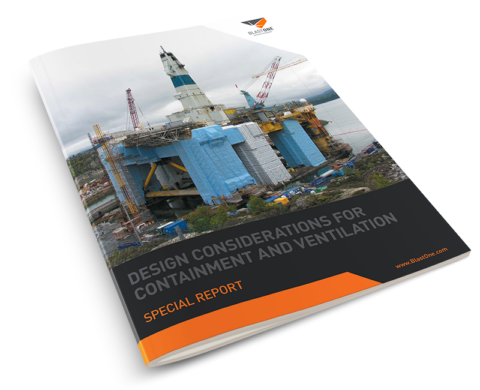DIY: 5 Easy Steps To Set-Up A Temporary Blasting Enclosure
We often see shipping containers used on jobsites to create temporary blasting areas. This can be where you have a project that a small amount of valves and other pieces that need blasting, and you can take them out of service to blast and paint them.
Other folks may have the situation that they need a blastroom area for just 1-2 days per month and they want somewhere to do it that is out of sight and contains the abrasive and dust from going everywhere.
Note 1: This set up is not a blasting area that allows you to recycle your abrasive, if that is your aim, you will benefit from a proper blastroom. We can help you with that, but it typically involves a discussion to get your needs met.
Note 2: This is strictly touching on a blasting area, talk to us if you need a painting set up, a painting area has to be explosion-proof and requires some other considerations
There are a few important factors to consider
1. VENTILATION
If a blaster can not see what they are doing, then you will have very poor work quality and often need to redo work. It is also a safety hazard if the blaster cannot see what he’s trying to do.
If a poorly set up area results in you having to do rework, you will loose a lot of time and money just doing material handling work. Often material handling is one of the most expensive parts of a project. So get the equipment right, and you will be streets ahead of your competitors.
2. Air Flow
You want the airflow to pass directly past the blaster and ventilate from the doors of the container, out the back.
Generally, if ducting is actually used, it is placed at the front opening of the container. Similar to our previous video inside a tank, if this duct is operating a suction vacuum, it’s merely pulling from the fresh incoming air. If it’s a fan blowing inward, creating positive pressure, it’s more than likely fanning billowing dust clouds trapped in the far end.
To effectively catch the dust, and minimize abrasive escaping outside, we recommend you install a baffle wall, that comes from the top of the container to 18” off the floor. Place this false wall about 12” from the back of the container
Cut a 12”-20” hole in the back of the container, toward the top, and attach a ventilation duct and ducting to this.
To create the draft, you can use a simple black max or blue wizard fan, which will create a good flow. If this is a more permanent set up, or you need more dust removal you can rent a dust collector for the project.
4. Lighting
It is important to have excellent lighting, as this allows the blaster to clearly see what they are blasting. Install 4-5 lights around the top rim angled toward the center of the container, this will create plenty of light, and minimize reword
5. Stop abrasive escaping
We recommend you install some simple doors, like what you would have on a chicken shed, with chicken mesh and some simple filter sheeting or shade cloth over it to stop the abrasive from exiting the area. Having a filter sheeting over the doors will still allow good airflow and some natural light into the area.
You can simply fold the doors completely out of the way and use these doors instead.
6. Recovering abrasive
To assist with collection of the abrasive that flows with the airstream, most of it will drop out as it starts to go back up the back baffle area, so add a piece of plywood on a 45 degree angle, and this will get the abrasive to flow back into the blast area, making it easy to collect with a shovel for disposal.
You could also cut a spot into the side of the container and make a small lean-to for a blastpot and easy disposal area.
 My Account
My Account



